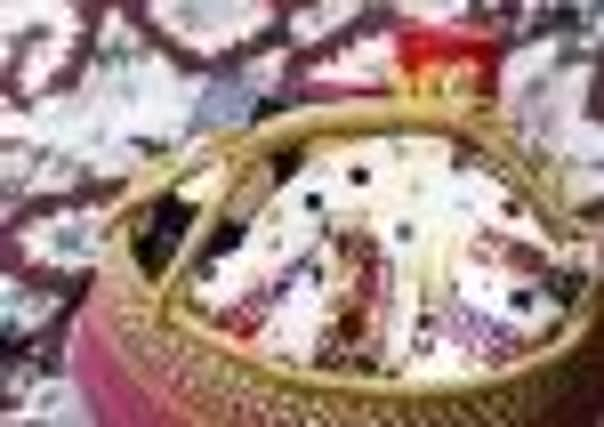A hard act to follow


We have reached the season where much time is spent deciding whether to dine inside or out – and having to hastily change your mind at the last minute. It is always a dilemma choosing what to eat off, as your best china and glass always seems a little more susceptible to breakage when used in the garden.
This summer sees a possible solution to all those problems with the resurgence in a great historical product, Melamine.
So here comes the science part!
Advertisement
Hide AdAdvertisement
Hide AdMelamine is a formaldehyde base compound originally invented in the 1830s by a German Scientist called Liebig. It is used to make floor tiles, counter tops, cooking spoons and even fabrics; as well as dinnerware. If moulded when warm, Melamine sets into a fixed form with a smooth, durable surface that resists most food stains, is virtually unbreakable and dishwasher safe.
It was first used for dinnerware when the US Navy commissioned a range from the Watertown Manufacturing Company during the Second World War, as they needed something more practical than china on rough seas. This range was designed by Jon Hedu and first sold to the public under the name of “Watertown Ware” in 1945.
The economic development of the US in the 1950s meant a domestic scramble for all things “space age” with the introduction of new time-saving domestic appliances. Melamine was quickly adopted as the epitome of modernity as households rejected traditional crockery, particularly under the innovative design eye of Russel Wright who developed cutting edge melamine dining sets for the Northern Chemical Company. The popularity quickly spread over the Atlantic.
Unfortunately, melamine developed a reputation for being prone to scratches and stains and fell out of favour with the public who began returning to ceramic, china and glass-made dishes. By the 1970s, Melamine was largely consigned to use in camping equipment and children’s dining sets.
Advertisement
Hide AdAdvertisement
Hide AdHowever, in the last few years it has found new favour with designers and is no longer solely the preserve of Peppa Pig or Scooby Doo. This is hardly surprising in an era when mid-century design is seeing a renaissance throughout all areas of the home.
Sales of vintage melamine products have risen dramatically on eBay and modern designers all now seem to be clamouring to use this practical product.
So the interior/exterior dilemma need worry you no further as the modern designs are extremely attractive with a slight edginess resulting in products that would not look out of place in any dining room.
Emma Bridgewater, the bastion of the modern English kitchen dresser, has developed a number of ranges which are smothered in delicious pattern – perfect for a picnic or just a pick me up.
Advertisement
Hide AdAdvertisement
Hide AdShe even has a melamine version of her iconic “Black Toast” range with suitably appropriate descriptive calligraphy (from £4; www.emmabridgewater.co.uk – 0844 243 9266).
Just to show how firmly this trend is entrenched in the UK, Cath Kidston has three different ranges (“Dotty”, “Flower” and “Daisy Pop”) which feature strong patterns and brilliant colours (from £3; www.kathkidston.co.uk – 08450 262 440).
Other designers have also joined the party by designing ranges for the High St with the likes of Jonathan Adler’s Neptune Salad plate for Heals and Ella Doran’s Indiantale range for Habitat.
Quirkiness (and not a little kitsch) seems to abound in a lot of the designs, with many museums and galleries introducing patterned plates. If you fancy nibbling off Napoleon then the new w2products National Gallery range features some of the funniest and most famous faces in the museum’s collection. There are four dinner plates, four side plates and a large platter (from £5; www.w2products.com – 0207 922 1444).
Advertisement
Hide AdAdvertisement
Hide AdThere are psychedelic patterns and 60s kitsch sprinkled throughout the designs. French Bull lead the way with their Pink Paisley and Ring Ranges (various stockists from £6); whilst the “Retro Inspired Marmite Tray” from We Love British will delight Anglophiles and Warhol fans alike (£11.95; www.welovebritish.co.uk – 01442 831991).
Indeed so strong is the current market that the Danish design firm Rice, who have a reputation for fairtrade homewares which combine strong design and good social ethics, have just opened a new “shop of funkiness” at 16a Neal’s Yard, London WC2 where you will be able to sample the delights of their entire range which starts at around £2.50 for a melamine beaker.
The High Street also has a terrific amount of melamine this summer. Some of the best examples include M&S’s Flower and Reef Ranges (from £2.50; www.marksandspencer.com) and John Lewis’s Summer Dot and Woodland Leaf designs (from £3; www.johnlewis.com).
Jamie Hempsall, BIID is an award winning interior designer. Visit him at www.jamiehempsall.com or call 0800 032 1180.
MINDING THE MELAMINE
Advertisement
Hide AdAdvertisement
Hide AdALTHOUGH it is unbreakable, Melamine should not be used in the microwave and never in the oven. It does tend to absorb heat, which can cause it soften, blister or potentially crack – so careful with extremely hot food. However, it is dishwasher safe. For scratches or stubborn stains use one of the especially designed cleaning products on the market, rather than a scouring powder or cream.